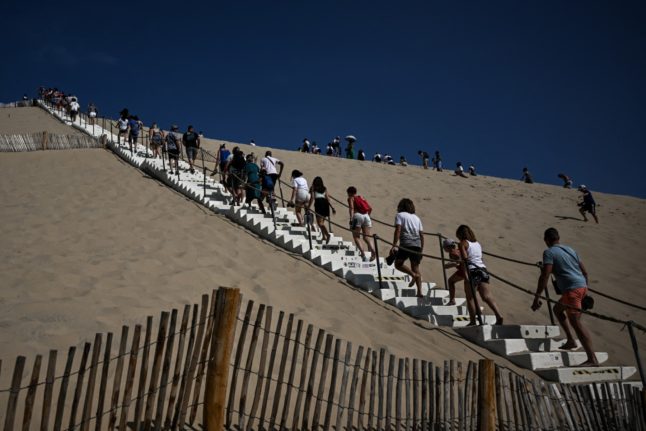France is understandably proud of its reputation as the world’s most visited tourist destination, but that tag does bring with it one or two problems.
According to the French government, some 80 percent of the country’s tourist activity – and there’s a lot of it – is concentrated in just 20 percent of the country, meaning that some better-known tourist sites can get overwhelmed by visitors.
And that has consequences, not only for the environment and holiday rental market, but also for the experience of visitors. A recent survey of readers of The Local appears to support this, with the Eiffel Tower and the Mona Lisa listed as the most overrated tourist attractions in France, and crowds listed as the biggest problem.
The French government intends to set up an Observatoire National des Sites Touristiques by the end of the year to monitor the impact of tourism on 15 popular tourist sites across the country, with the intention of expanding the reach of the survey later.
READ ALSO Six reasons why France is so popular with tourists
So what are the most visited sites in France?
According to Franceinfo, the 10 French tourist attractions likely to suffer the worst from over-tourism this summer are:
Étretat – Some 10,000 visitors a day – or 1.5 million people per year – head to the beaches and cliffs of Étretat, Normandy (the town has a year-round population of just 1,200). And the area is suffering, according to local authorities. The habitat that brings tourists is slowly being destroyed, while the lives of locals are made a misery by traffic jams and careless tourists.
Mont-Saint-Michel – the atmospheric abbey off the Normandy coast got almost 3 million visitors last year and is the most-visted French tourist site outside of the Paris region. Limits have been in place for the summer season for some time, and the French government has also been running a ‘visit in winter’ advertising campaign, urging people to visit the monument outside of the peak summer season.
Ile de Bréhat – In 2023, the picturesque Breton island of Bréhat – population 400 – set a daily visitor limit of 4,700 in July and August, some 1,300 lower than the previous daily average.
Ile de Noirmoutier – down on France’s west coast is another picturesque island, Noirmoutier – famous for potatoes and very popular with French visitors. Officials on île de Noirmoutier are considering reintroducing a toll to control visitor numbers, with some 100,000 people expected in high season, more than 10 times the tiny island’s usual population.
Dune du Pilat – the largest sand dune in Europe and part of the beautiful stretch of wooded coastline just south of Bordeaux. Its fame has come at a cost, however, as the roughly 1.3 million visitors per year are damaging the dune itself and the fragile ecosystem that surrounds it.
Mont-Blanc – local authorities have introduced rules to limit the number of people seeking to climb western Europe’s highest peak to 214 per day between May and September. There is increasing concern about the environmental damage that visitors do as well as safety concerns – warming temperatures have made avalanches more common in the Alps. The mayor of the town at the foot of Mont Blanc wants to introduce a ‘funeral fee’ deposit, to cover the cost of visitors who need rescuing.
Parc national des Calanques – close to Marseille, the Calanques national park is one of the most stunning parts of France and is highly popular with tourists. So popular that visitor numbers are now limited to prevent environmental damage – access to the calanque de Sugiton and the Pierres Tombées, on the Mediterranean coast, has to be pre-booked during the high season, with access limited to 400 visitors per day.
Iles du parc national du Port-Cros; – the îles du parc national du Port-Cros, covers the islands of Porquerolles, Port-Cros and Levant off the Var coast and was the victim of major overcrowding – up 1.5 million people were heading to the fragile islands between the beginning of June and the end of August every year. In 2023 a 6,000-visitor daily limit was imposed.
Vallon-Pont-d’Arc in the Gorges de l’Ardèche – the naturally-occurring stone ‘bridge’ over the Gorge is one of the most photographed sites in France, and the Gorges themselves are dream for anyone interesting in canoeing, kyaking or hiking in stunning scenery – almost 2 million people visit every year which has led to environmental damage and long queues for certain activities.
The GR20 in Corsica – part of France’s popular network of GR hiking trails, the Corsica route is especially popular with tourists and international hiking groups, taking in as it does the island’s beautiful scenery and offering some challenging climbs. There is currently no visitor limit in place.
Are there any alternatives?
Oh yes. France is fairly overflowing with places to visit. Rather than going to Étretat, Franceinfo suggests trying nearby Avranches and Granville or Fécamp (home to Benedictine liqueur).
Head to the the Vanoise and Beaufortain massifs rather than Mont Blanc; the Côte Bleue to the west of Marseille is every bit as beautiful – and less busy – than the Calanques; while opposite Cannes, the Lérins Islands, are an ideal alternative to the îles du parc national du Port-Cros.
Then, you could think a little outside the France tourist box.
READ ALSO 19 alternative places to visit in France to avoid the crowds



 Please whitelist us to continue reading.
Please whitelist us to continue reading.
Member comments